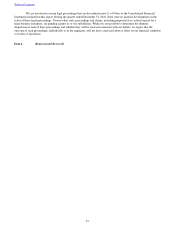Sprint - Nextel 2010 Annual Report Download - page 29
Download and view the complete annual report
Please find page 29 of the 2010 Sprint - Nextel annual report below. You can navigate through the pages in the report by either clicking on the pages listed below, or by using the keyword search tool below to find specific information within the annual report.
Depreciation and Amortization Expense
Depreciation expense decreased $753 million, or 13%, in 2010 compared to 2009 and $137 million, or 2%, in 2009
compared to 2008 primarily due to a reduction in the replacement rate of capital additions resulting from reduced capital
spending associated with our cost control actions beginning in 2008. The average annual capital expenditures for the three
years ended 2007 were approximately $6.3 billion as compared to average annual capital expenditures of $2.5 billion for the
three years ended 2010. Amortization expense declined $415 million, or 26%, in 2010 compared to 2009 and $854 million, or
35%, in 2009 as compared to 2008, primarily due to reductions in amortization of customer relationship intangible assets as a
result of those related to the 2005 acquisition of Nextel becoming fully amortized. These reductions were partially offset by an
increase in amortization related to customer relationship intangible assets acquired in connection with the iPCS, Inc. (iPCS) and
Virgin Mobile acquisitions in the fourth quarter 2009. Customer relationships are amortized using the sum-of-the-years'-digits
method, resulting in higher amortization rates in early periods that decline over time.
Goodwill Impairment and Merger and Integration Expenses
The Company recognized a non-cash goodwill impairment of $963 million during 2008. The impaired goodwill was
primarily attributable to the Company's acquisition of Nextel in 2005 and reflects the reduction in the estimated fair value of
Sprint's wireless reporting unit subsequent to the acquisition resulting from, among other factors, net losses of postpaid
subscribers. Merger and integration expenses decreased $130 million, or 100%, in 2009 compared to 2008 as integration
activities were completed during 2008.
Other, net
The following table provides additional information of items included in “Other, net” for the years ended
December 31, 2010, 2009 and 2008.
Severance and exit costs
Asset impairments
Gains from asset dispositions and exchanges
Other
Total
Year Ended December 31,
2010
(in millions)
$(8)
(125)
69
84
$ 20
2009
$(400)
(47)
68
(10)
$(389)
2008
$(355)
(480)
29
—
$(806)
Other, net improved $409 million, or 105%, in 2010 compared to 2009 and $417 million, or 52%, in 2009 compared
to 2008. During 2010 we recognized $8 million of severance and exit costs primarily related to exit costs incurred in the second
and fourth quarter 2010 associated with vacating certain office space which is no longer being utilized. We recognized $400
million and $355 million in 2009 and 2008, respectively, of severance and exit costs related to the separation of employees and
organizational realignment initiatives. Asset impairments increased by $78 million, or 166%, in 2010 compared to 2009 and
decreased $433 million, or 90%, in 2009 compared to 2008. Asset impairments primarily relate to assets that are no longer
necessary for management's strategic plans. In 2010 and 2009 these costs were primarily related to network asset equipment.
Asset impairments in 2008 also include previously recognized cell site development costs. Gains from asset dispositions and
exchanges for 2010, 2009, and 2008 are primarily related to spectrum exchange transactions. Other increased $94 million
primarily due to an increase in benefits resulting from favorable developments relating to access cost disputes with certain
exchange carriers in 2010 as compared to 2009.
Interest Expense
Interest expense increased $14 million, or 1%, in 2010 as compared to 2009. This increase was primarily due to
higher effective interest rates on our average long-term debt balances and increased costs on our revolving credit facilities,
which include the accelerated amortization of previously unamortized debt issuance costs from the retirement of our former
credit facility in May 2010 partially offset by reductions in interest expense previously recorded as a result of favorable tax
outcomes. Interest expense increased $88 million, or 7%, in 2009 as compared to 2008, as fewer capital projects led to a
decrease of $111 million of capitalized interest partially offset by a decrease of $56 million related to a $1.5 billion decline in
the weighted average long-term debt balance between the comparative periods. The effective interest rate on the weighted
average long-term debt balance of $20.6 billion, $21.4 billion and $22.9 billion was 7.2%, 6.8% and 6.6% for 2010, 2009 and
2008, respectively. See “Liquidity and Capital Resources” for more information on the Company's financing activities.
Table of Contents
27
























